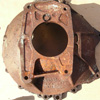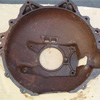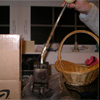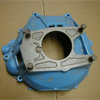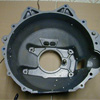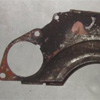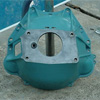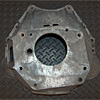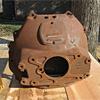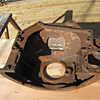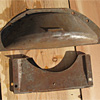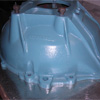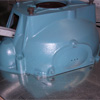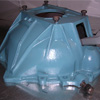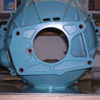1961- 1968 Bellhousing Identification
Here is the 1961 Ė 1962 bellhousing GM Part #538090.
As with ALL 61 to 64 Pontiac big car bellhousings, the manual transmission mounts at a 15 degree angle to being straight. Why? Who knows!? Ever take a close look at a REAL 61 to 64 Pontiac shifter? Let's look at a Hurst shifter for a 63-64 Grand Prix.
Here is my buddy Pat holding his shifter at pretty much a 90 degree angle. Note the 15 degree bend in the stick. Now, remember this… If you put a regular shifter in your big Pontiac using the factory bell- housing, plan on having the shifter either hooked to your right leg or when you catch that hard second gear…NO MORE KIDS! Can you take a regular shifter and bend the stick? I guess you can, however I would bend it cold. DO NOT heat it up. Maybe best to have a shop do it on a hydraulic press. I have not done this so you’re on your own!
Correct 1963 only big car bellhousing GM Part #977091. Again, note the 15 degree tilt. Correct 1964 bellhousings are discussed below. Please note that all 61 to 64 bellhousing appear to be interchangable.
Inside view of #9770091. The 61-64 units have two starter bolt holes.
1961 -1964 dust cover-inspection plate. These are becoming quite hard to find. The bottom inspection covers are also hard to find.
OK, beware of morons that read too many books. Some idiot out there wrote a GTO book that says the 1964 ALUMINUM GTO bellhousing is the same as big Pontiacs. THIS IS NOT TRUE. The bellhousing shown above is GM Part #9773320. It has NO provisions for a back bolt starter as 64 GTO’s were the first Pontiac engine to use an up bolt starter. 64 on back big cars were NOT drilled to accept an up bolt starter. Can you image a starter mounted to this flimsy aluminum bellhousing? I got had by a fellow eBayer and now have this “trophy” hanging on my wall to remind me that this was complete crap.
This is the correct bellhousing for 65 on up. Part #9785581. These also have a dust cover. Some these are incorrect as they have dual mounts (starter can mount on either side). This was done to make the same bellhousing work on Buick, Olds & Pontiac. Cadillac & Chevy have there own bolt pattern. NEVER buy a bellhousing that has been cut, modified or is cracked IN ANY WAY. I recommend having your bellhousing Magnafluxed or dye penetrant tested before use ALWAYS.
OK, just for comparison, here is a 59-60 bellhousing. Note the trans mounts straight. This is GM part # 528820.
Check out the bizarre inside view of the 59-60 bellhousing!
Here are both inspection covers for the 59-60 bellhousing. My thanks to Jerry at ggt74@aol.com for sharing these photos.
OK, 1964 bellhousings appear to 64 only. Some have the casting number of 9773762-1, while other sport the number 9776383. Going by casting number sequence alone, it would seem to dictate that for whatever reason, 64 bellhousing have these two numbers.
Donít go by the throwout bearing arm as itís the same as the repro version we sell. Correct bottom cover plate too.
Clutch ball stud in the right location...
And yes, it has the ever popular 15 degree tilt that all FACTORY 61-64 bellhousing have for mounting your transmission. Still looking for the reason this was done. This made using a regular shifter out of the question. Thanks to John Freeman for these nice photos! Also, thanks to Tom Gardner for sharing info on this subject.
A final word on bellhousings....I cannot stress enough to not just use some bellhousing you found or bought without blasting it inside & out and then have it Magnafluxed (if it's cast) or dye penetrant checked (if it's aluminum). Both are non-destructive testing and might just save your life or the life of your passenger. I had a friend of mine killed in high school as his 55 Chevy with the original cast iron bellhousing blew apart at speed. It literally ripped his car apart, killing him in he process. Since then, I have never used a used bellhousing without checking it out. I have tossed out 5 cast iron bellhousings in the past three years as cracks were found. None you could see without testing. PLEASE, use this information and make the right choice.

